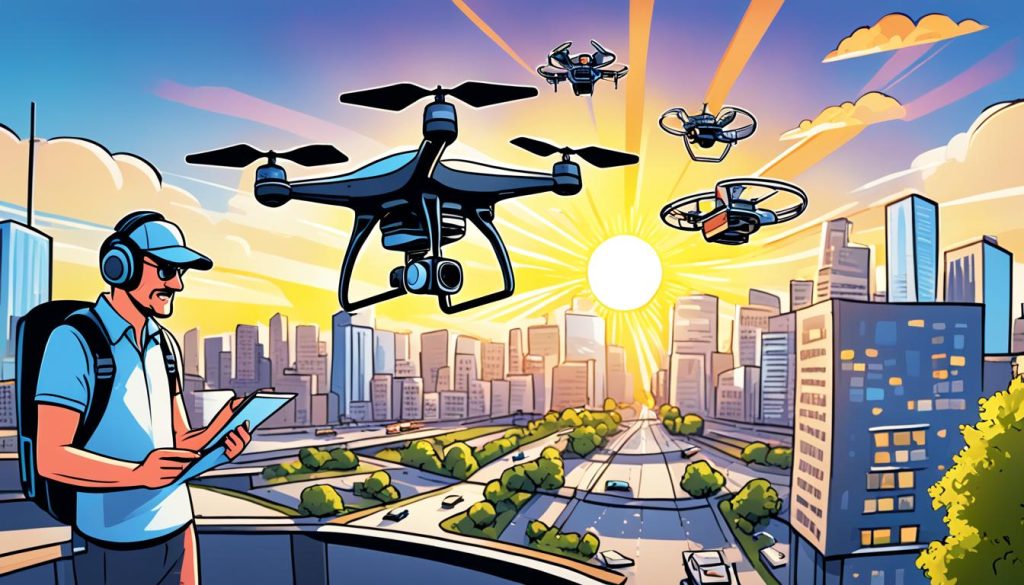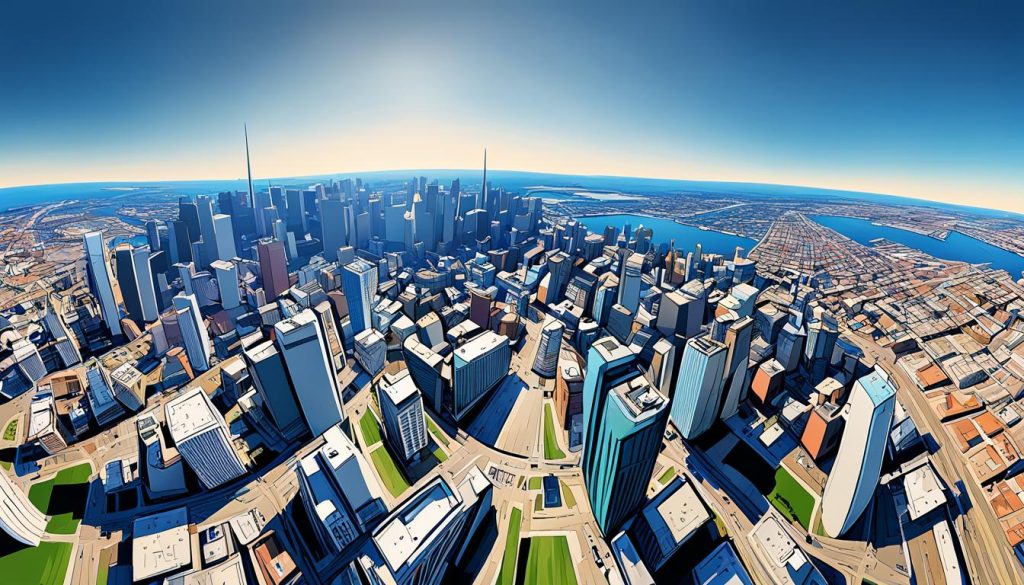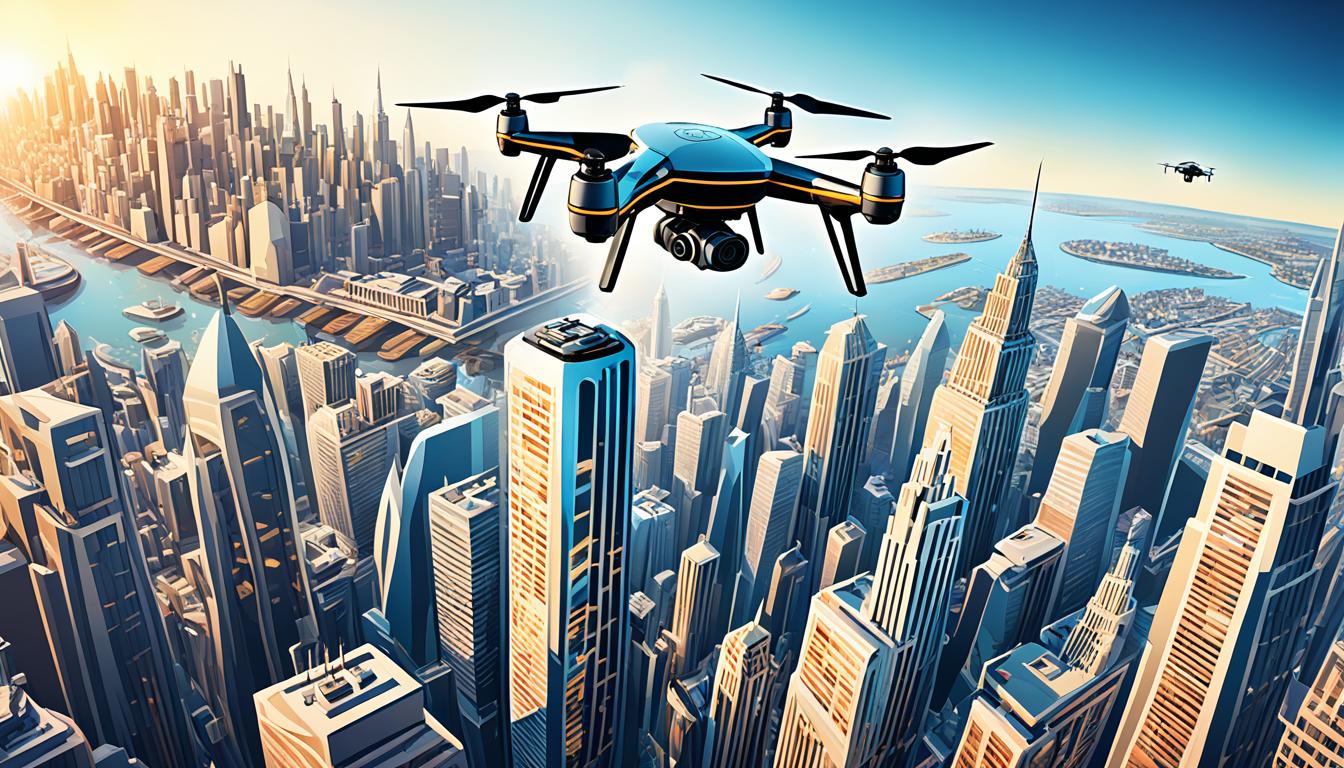To get flight permits for vertical panorama shoots in restricted areas, you must understand drone photography permissions and aerial imaging rules. It’s key to know these rules to take amazing vertical panoramic photos while following airspace rules.
Drones have changed landscape photography, giving us new ways to see the world from above. They can go to places hard to reach and capture stunning views. With high-resolution cameras, they make aerial photography better than ever.
Dealing with drone photography laws can be hard, especially in restricted areas. You need to learn about local and federal rules, find no-fly zones, and get the right permits before flying your drone for those amazing vertical shots.
Understanding Drone Regulations for Landscape Photography
Knowing the rules for drones is key for great shots. It’s important whether you fly for fun or need official permission. Let’s look at how drone laws affect your photography.
National Park and Wilderness Area Restrictions
In U.S. national parks, drones need special permits. These are usually for research, not fun flying. In wilderness areas, you can’t take off or land, but you can fly over if you start outside. This rule changes how you plan your shots in these beautiful spots.
State Park Regulations
State parks have their own drone rules. Some don’t allow drones at all. Always check with the park before you go. Some parks might need you to ask for permission before you take photos with a drone.
Using the B4UFLY App for Airspace Safety
The B4UFLY app is a must-have for drone pilots. It’s available on many devices and shows where you can fly safely. Just enter your location to see where it’s okay to fly.
| Platform | B4UFLY Availability | Key Features |
|---|---|---|
| Apple iOS | Yes | Interactive maps, real-time alerts |
| Android | Yes | Location-based services, airspace info |
| Windows | Web version | Coordinate-based checks, flight planning |
Understanding these rules helps you fly safely and legally. Always follow the drone laws for smooth and legal photography.
The Importance of Vertical Panoramas in Drone Photography
Vertical panoramic photography brings a new level to drone shots. It lets you capture scenes from top to bottom. This shows the full height and scale of your subjects, perfect for tall buildings, natural scenes, and cityscapes.
Using vertical panoramas in your drone shots tells a fuller story. You can see details from the ground to the sky in one shot. This view is hard to get with regular horizontal shots.
Benefits of Vertical Panoramas
- Showcase full height of subjects
- Create visually striking compositions
- Stand out in portfolios and social media
- Capture more detail in a single image
- Offer unique perspectives of familiar scenes
To make vertical panoramas, learn some aerial imaging tricks. Plan your shot well, thinking about the subject’s height and the area around it. Use your drone’s gimbal to take a series of vertical shots, starting from the bottom and going up. Then, stitch these shots together in post-processing to make your panorama.
Vertical panoramic photography can really boost your drone portfolio. These striking images will catch people’s eyes on social media and in client meetings. By getting good at this, you’ll have a strong skill to set your drone photos apart.
Selecting the Right Drone for Vertical Panorama Shoots
Finding the right drone for vertical panorama shots is key. Let’s look at a top choice and see what it offers.
DJI Mini 4 Pro: A Lightweight Powerhouse
The DJI Mini 4 Pro is great for vertical panoramas. It’s super light, under 250 grams, making it easy to carry and follow the rules. It flies smoothly and precisely, thanks to its stable controls and GPS.
Impressive Camera Specifications
The DJI Mini 4 Pro has amazing camera specs. It has a 48-megapixel camera that shoots 4K video. The camera’s 1/2.3-inch sensor and f/1.7 lens take beautiful photos. You can choose from 12 or 48-megapixel modes and HDR for tough lighting.
Battery Life for Extended Shoots
The DJI Mini 4 Pro has great battery life for drones. It flies up to 21 minutes on one battery, giving you lots of time to get your shots. This means you can try different angles and settings to get it just right.
| Feature | Specification |
|---|---|
| Weight | Less than 250g |
| Camera Resolution | 48MP |
| Video Capability | 4K |
| Sensor Size | 1/2.3-inch |
| Aperture | Fixed f/1.7 |
| Focal Length | 24mm equivalent |
| Flight Time | Up to 21 minutes |
Preparing for Your Vertical Panorama Shoot
Getting ready for drone photography is key to capturing amazing vertical panoramas. You need to plan well and pay attention to details. Here are the main steps for a successful shoot.

First, check the weather before you start. Wind speed is important for drone stability. Use tools like windy.com to see wind speeds and gusts. The DJI Mini 4 Pro can handle up to 24 mph winds, but less wind is better for photos.
Don’t forget about battery life. Wind can make batteries drain faster. Bring extra batteries and make sure they’re fully charged. Also, have extra memory cards ready. This way, you won’t miss out on great shots because of technical problems.
Choose your shooting spot carefully. Look into local drone laws and find out where flying is not allowed. This is crucial for flying safely and legally. Plan your flight and shots to make the most of your time and follow the rules.
- Check weather forecast, focusing on wind speeds
- Prepare all equipment, ensuring full charges
- Research local drone regulations
- Plan your flight path and shooting locations
- Pack essentials: spare batteries, memory cards, and lens cleaning kit
By doing these prep steps, you’ll be ready for a great vertical panorama shoot. Remember, good preparation means amazing photos and safe flying.
Obtain Flight Permits for Vertical Panorama Shoots in Restricted Areas
Getting drone flight permits for vertical panorama shoots in restricted areas is key. You need to find out where you can’t fly, talk to the authorities, and fill out detailed applications. Let’s go through these steps to make sure you get the UAV authorization for your photography project.
Identifying Restricted Areas
First, use official sources to find out where you can’t fly. The B4UFLY app is a great tool for checking airspace rules. It gives you real-time info on no-fly zones and helps you plan safe, legal flights. Remember, these areas include national parks, military bases, and places near airports.
Contacting Relevant Authorities
After finding a restricted area, contact the right authorities. This could be local park services, airspace controllers, or government agencies. Tell them about your project, like the vertical panorama shoot and your drone’s details. Be ready to talk about your safety steps and flight plan.
Submitting Permit Applications
The last step is to send in your permit application. This should have:
- Your detailed flight plan
- Purpose of the shoot
- Drone specs
- Safety protocols
- Proof of drone registration
- Pilot certification (if needed)
Make sure your application is complete to boost your chances of getting clearance. Some places might ask for more info or have special forms for drones. Always check on your application and be patient, as it can take time.
Techniques for Capturing Vertical Panoramas
Mastering vertical panorama composition is key for amazing drone photos. Let’s dive into methods to boost your aerial shots.
Manual Bracketing for Enhanced Dynamic Range
Use manual bracketing to take stunning vertical panoramas. This method boosts dynamic range, especially in 48-megapixel mode. With the DJI Mini 4 Pro, you can take 3-shot brackets for 48MP images. This ensures rich detail in both bright and dark areas.
Using the Gimbal for Vertical Composition
Your drone’s gimbal is vital for precise vertical shots. Tilt the camera slowly and steadily for overlapping shots. This helps create smooth transitions between frames, which is key for stitching later.
Post-Processing and Stitching Techniques
After flying, enhance your vertical panorama. Use Adobe Lightroom to stitch RAW files for better quality. Apply noise reduction techniques, especially for low-light shots, to keep images clear.
| Technique | Benefits | Considerations |
|---|---|---|
| Manual Bracketing | Enhanced dynamic range | Requires stable drone position |
| Gimbal Use | Precise vertical composition | Practice smooth tilting motion |
| RAW Stitching | Higher quality panoramas | Demands more processing power |

By using these drone photography tips, you’ll make stunning vertical panoramas. These will show landscapes in a unique and eye-catching way. Practice and try different settings to find what works best for you.
Safety Considerations for Drone Operations
Flying drones safely is key for legal flying and keeping people and property safe. Using strong drone safety rules and following UAV guidelines helps make your aerial photoshoots go smoothly. It also cuts down on risks.
First, learn the local flying rules. Always keep your drone in sight. This keeps you in control and avoids dangers. Watch out for the wind, as it can make flying hard and use up your battery fast.
Use your drone’s safety features. Systems that avoid obstacles and return-to-home functions can save you in tricky situations. Always think about the safety of people and things below and in the air.
Before you fly, go through a detailed checklist. Check your drone for any damage, make sure the batteries are full, and everything is in place. Also, look for any dangers like power lines or trees in your flying area.
| Safety Measure | Description | Importance |
|---|---|---|
| Visual Line of Sight | Keep drone visible at all times | Critical for control and hazard avoidance |
| Wind Awareness | Monitor wind speed and direction | Affects stability and battery life |
| Obstacle Avoidance | Use built-in sensors to detect objects | Prevents collisions and damage |
| Return-to-Home Function | Automated return if signal is lost | Ensures safe recovery of drone |
| Pre-Flight Checklist | Inspect drone and surroundings | Identifies potential issues before flight |
Following these drone safety rules and UAV guidelines makes your aerial photoshoots safer. It also keeps drone flying in a good light.
Navigating Weather Conditions for Optimal Shots
Weather is key in drone photography. Knowing how to handle the weather can help you get amazing shots. Let’s look at how to pick the best weather for your drone photos.
Wind Speed and Its Impact on Drone Stability
Wind affects drones a lot. Strong winds can make your drone unstable, shorten its battery life, and lower image quality. Most drones have wind speed limits. Flying in calm weather gives you the best shots.
| Wind Speed | Impact on Drone | Recommended Action |
|---|---|---|
| 0-5 mph | Minimal impact | Ideal for flying |
| 6-10 mph | Slight movement | Fly with caution |
| 11-15 mph | Noticeable instability | Experienced pilots only |
| 16+ mph | High risk of instability | Avoid flying |
Using Weather Forecasting Tools
Good weather tools are a must for drone flying. Apps like Windy show wind speed and gusts. Always check the forecast before flying to make sure it’s safe.
Don’t forget about the light. Early morning or late afternoon have the best light for drone photos. By thinking about these things, you’ll fly safely and get great shots.
Legal and Ethical Considerations in Drone Photography
When you start drone photography, you must understand UAV legal rules and drone photography ethics. You have to do more than just take great pictures. You must respect privacy, property rights, and the environment too.
It’s key to know the local laws about drones and taking pictures from the air. Each place has its own rules. For work, you’ll need the right permits. This keeps you legal and shows you’re professional and respectful.
Privacy is a big deal in drone photography. Always ask before taking pictures of private places or people. Watch where you fly to avoid places like schools or government buildings without permission.
Think about how your drone affects the environment. Drones can scare away animals and harm nature. Before you go, learn about the place and follow rules for safe flying in nature. This might mean flying less or keeping away from animals.
By following UAV laws and ethical drone photography, you help drones get a good name. This careful way of flying means we can keep enjoying the sky for photography. And we respect everyone’s rights and safety.
Showcasing Your Vertical Panoramas: Portfolio and Social Media Tips
Your drone photography portfolio is crucial for showing off your vertical panoramas. Make sure it has a mix of different styles and subjects. Include cityscapes, natural landscapes, and unique views to keep people interested. This variety shows off your skills to potential clients.
Social media is great for sharing your aerial shots. Use sites like Instagram and Facebook to post your best work. Add hashtags like #dronephotography or #verticalpanorama to help others find your photos. Talk to people in the comments and follow other photographers to grow your network.
Give your followers a behind-the-scenes look at your work. Share your drone setup or short videos of your flights. This kind of content makes your work more interesting and personal. It can also make people curious about how you create your vertical panoramas.
Don’t overlook showing your work offline too. Large-format prints can really highlight the detail in your vertical panoramas. Look for high-quality printing services that offer big photos. These prints could be great for galleries, offices, or even your own studio.






